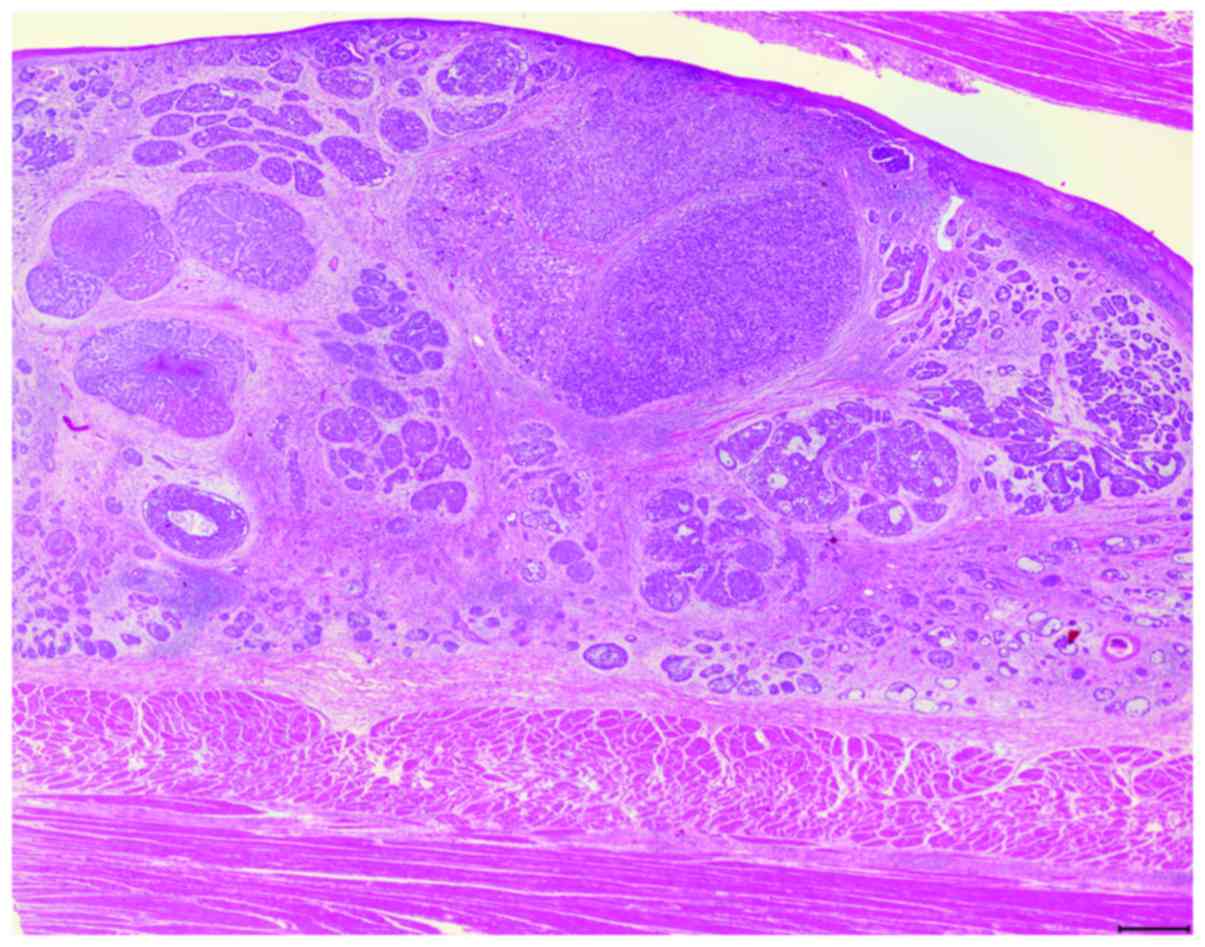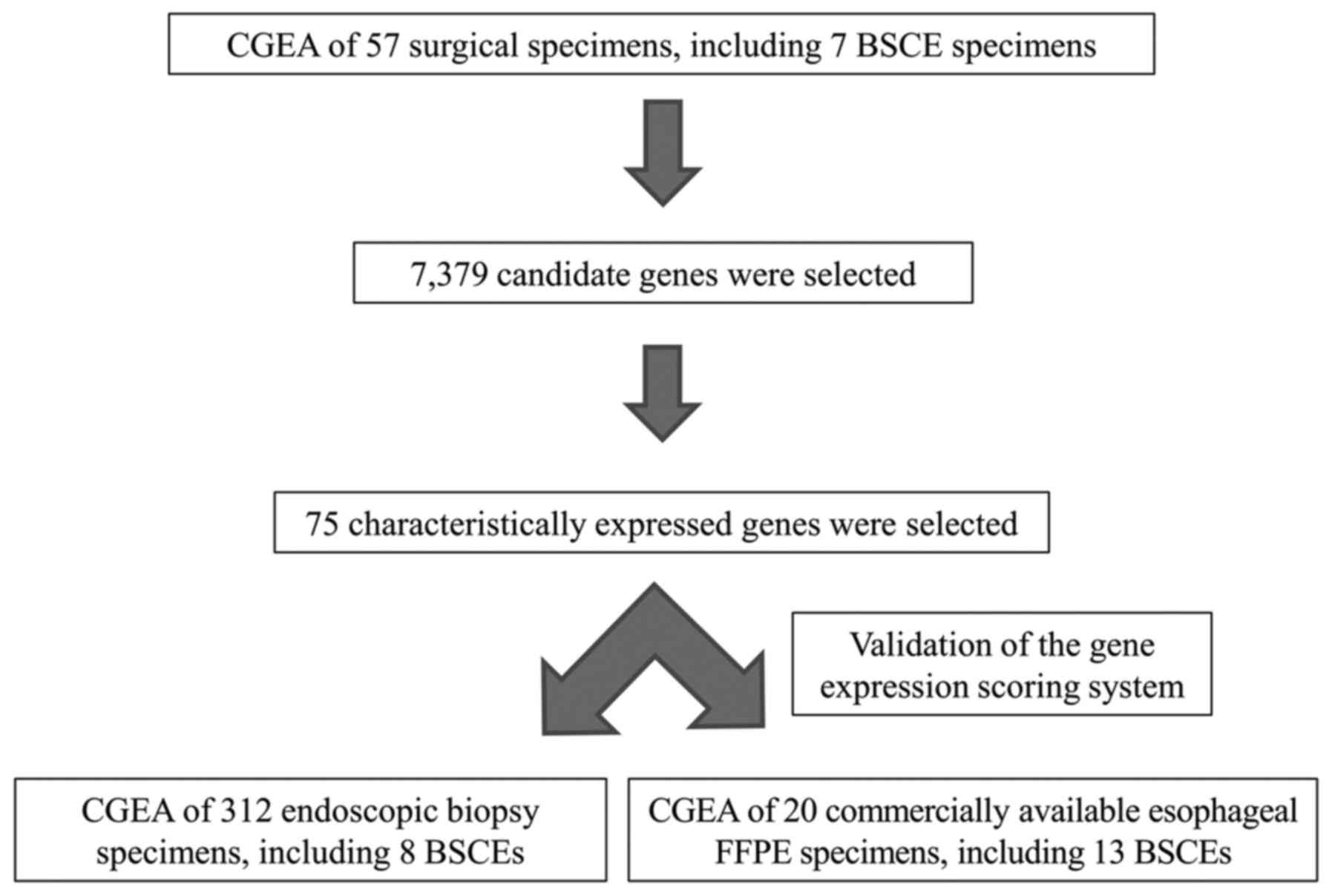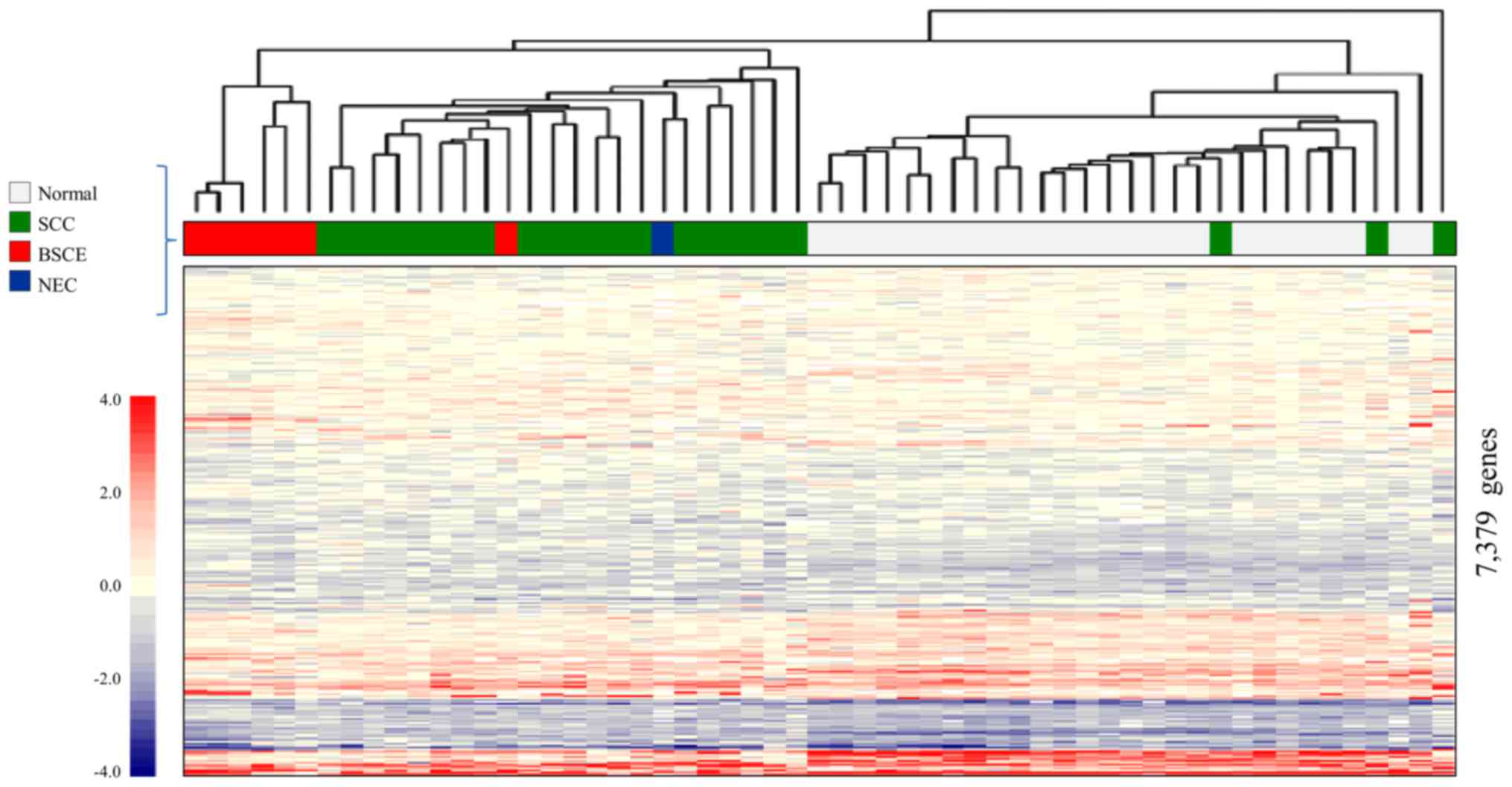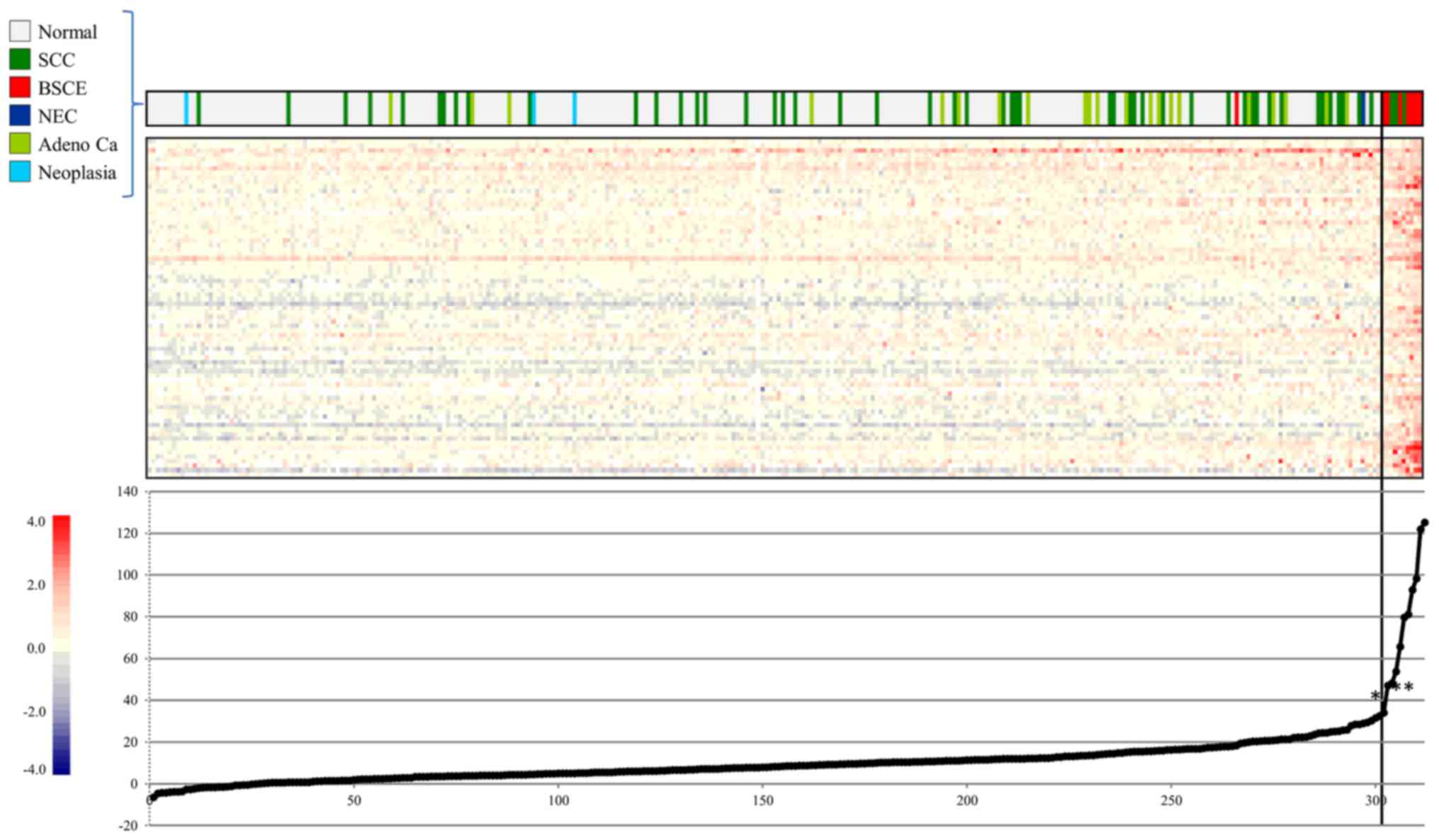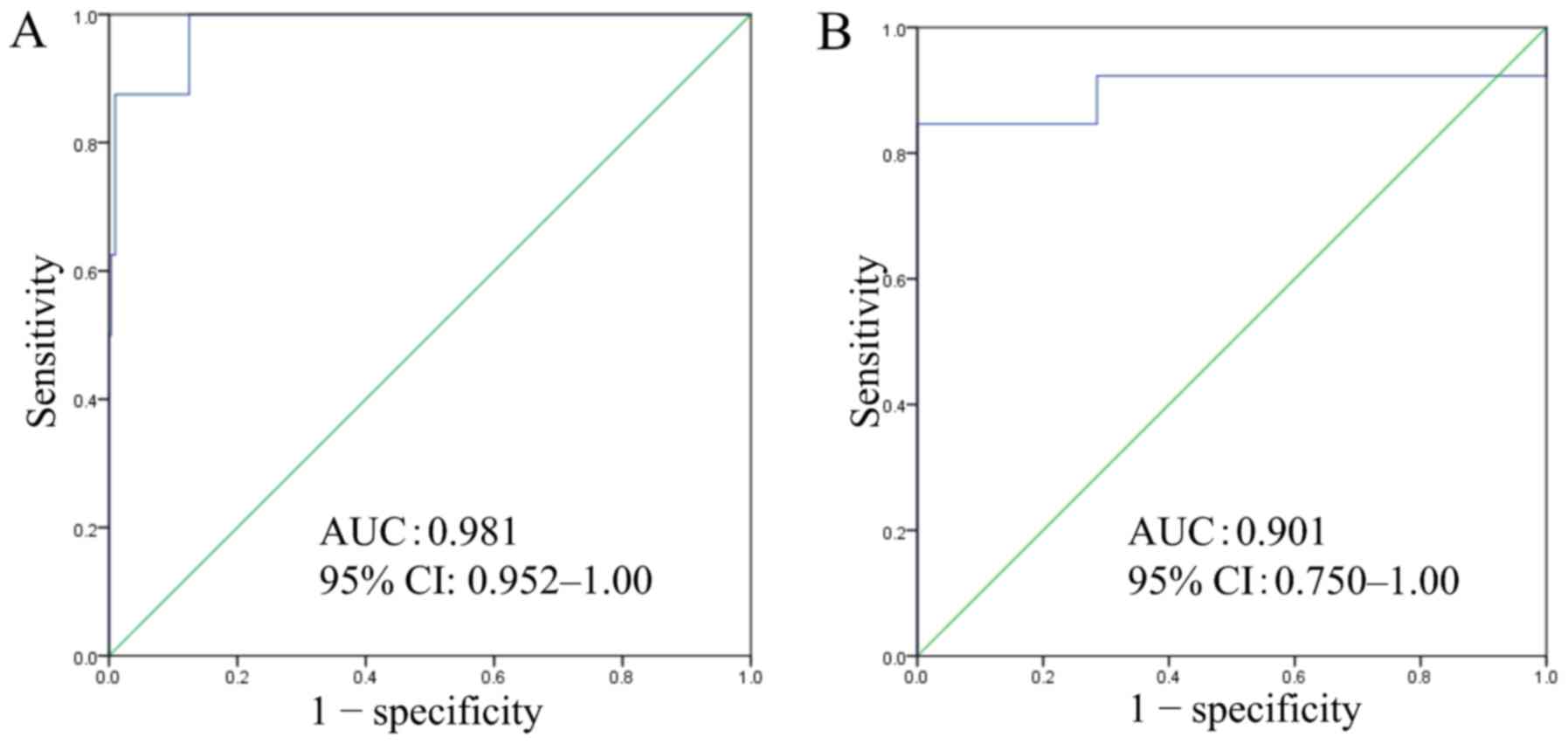A novel gene expression scoring system for accurate diagnosis of basaloid squamous cell carcinoma of the esophagus
- Authors:
- Published online on: July 19, 2017 https://doi.org/10.3892/ijo.2017.4075
- Pages: 877-886
Abstract
Introduction
Basaloid squamous cell carcinoma (BSC) was first reported by Wain et al (1) to occur in the head and neck region. BSC may occur in various other sites, including esophagus (2), lung (3), anus (4), uterine cervix (5), penis (6), and urinary bladder (7). BSC of the esophagus (BSCE) is a rare and uncommon variant of squamous cell carcinoma (SCC), with a reported incidence ranging from 1.0 to 8.7% (8–16) in Japan and 0.4 to 11.3% (2,17–24) in other countries.
BSCE has six typical components on histology: solid nest with central necrosis, cribriform pattern, ductal differentiation, microcyst and/or trabecular nests, hyaline-like material deposition, and coexistence of SCC components (16). Because of these histological varieties, BSCE is difficult to distinguish from adenoid cystic carcinoma, small cell carcinoma, poorly differentiated SCC, or adenosquamous carcinoma (2,23,25,26). Furthermore, it is even more difficult to diagnose BSCE based on the histological examination of endoscopic biopsy specimens, with a low diagnostic accuracy of only 0–10% (23,24,27). BSCE has been frequently diagnosed as SCC on endoscopic biopsy specimens, probably because of the fact that BSCE frequently presents as a submucosal tumor-like structure covered with normal epithelium or SCC (14,15). Therefore, sampling multiple and deeper sites is recommended for diagnosis by endoscopic biopsy (24,27). Some diagnostic approaches using immunoreactivity (2,9,12,16,18,19) or polymerase chain reaction (PCR) (28,29) have been reported, but none of these showed high specificity for BSCE.
The prognosis of BSCE is still controversial. Some studies stated no significant difference between BSCE and SCC (2,20), whereas others stated poorer prognosis of BSCE than that of SCC (16,17,23). Some authors specified that BSCE shows a poor degree of differentiation, high proliferative activity (2), aggressive biological behavior (16), high telomerase activity (20), and a worse prognosis than that in SCC in advanced cases (30). Meanwhile, other authors mentioned that the treatment for BSCE is similar to that for SCC of the esophagus (15,23). The rarity of and difficulty in the proper diagnosis of BSCE (15) may be responsible for this diversity. Therefore, proper diagnosis is mandatory for analyzing the outcome and determining the suitable treatment for this disease entity.
We have previously reported the use of comprehensive gene expression analysis (CGEA) to identify some disease-specific genes (31,32). The present study aimed to improve the diagnostic accuracy for BSCE by attempting to extract the genes expressed in it. From CGEA of esophagectomy specimens, we constructed, verified, and evaluated a gene expression scoring system for the proper diagnosis of BSCE.
Materials and methods
Patient selection
We initially enrolled all 113 esophageal cancer patients who underwent esophagectomy and/or endoscopic biopsy at Fukushima Medical University Hospital from January 2008 to July 2015. Among these patients, 14 patients (1 in stage 0, 4 in stage II, 4 in stage III, 4 in stage IVa, 1 in stage IVb and 1 in unknown stage) were not followed in our department, and one surviving patient (stage II) denied to participate in research. These cases were excluded.
Ethics statement
This study was approved by the ethics committee of Fukushima Medical University (approval no. 1953). Written informed consent was obtained from 98 patients.
Commercially available esophageal specimens
From US Biomax Inc. (Rockville, MD, USA), we purchased 20 formalin-fixed paraffin-embedded (FFPE) specimens that were diagnosed to have BSCE components. These FFPE specimens were reviewed by three pathologists before inclusion.
Specimen sampling
Small fractions (7×7 mm) of the cancerous site and normal mucosa were removed from each surgical specimen and were immediately frozen in liquid nitrogen before performing CGEA. Residual tissue specimens were fixed in formalin and then embedded in paraffin before pathological examination.
For the biopsy specimens, tiny fractions (3×3 mm) of the esophageal epithelium, including cancerous and normal sites, were obtained endoscopically; they were immediately frozen separately in liquid nitrogen before performing CGEA. Another specimen from near the first biopsy site was obtained endoscopically; it was fixed in formalin and embedded in paraffin before pathological examination. We made an effort to sample multiple and deeper sites by endoscopic biopsy. We ascertained that the frozen specimens for CGEA and the FFPE specimens for pathological examination had identifiable pathological features.
Pathological review
The surgical, endoscopic biopsy and commercially available FFPE specimens were stained with hematoxylin and eosin and were reviewed by three pathologists (Fig. 1). BSCE was defined using the criteria described by Wain et al (1); the six component histological features reported by Imamhasan et al (16) were also evaluated. In this study, tumors that contained some BSC components within SCC were categorized as BSCE.
Comprehensive gene expression analysis
Frozen specimens were processed for total RNA extraction using Isogen (Nippon Gene Co., Ltd., Tokyo, Japan) and for poly(A)+RNA purification using MicroPoly(A) Purist kit (Ambion, Austin, TX, USA). Commercially available FFPE specimens were processed for total RNA extraction using ISOGEN PB kit (Nippon Gene Co., Ltd.). The human common reference RNA was prepared by mixing equal amounts of total RNA and poly(A)+RNA, which were extracted from 22 human cancer cell lines (A431, A549, AKI, HBL-100, HeLa, HepG2, HL60, IMR-32, Jurket, K562, KP4, MKN7, NK-92, Raji, RD, Saos-2, SK-N-MC, SW-13, T24, U251, U937, and Y79).
The DNA microarray that used poly(A)+RNA was named system 1; a set of synthetic polynucleotides (80-mers) representing 31,797 species of human transcript sequences was printed on a glass slide using a custom arrayer. The DNA microarray that used total RNA was named system 2; a set of synthetic polynucleotides (80-mers) representing 14,400 species of human transcript sequences was printed on a glass slide using a custom arrayer. For RNA of the samples, SuperScript II (Invitrogen Life Technologies, Carlsbad, CA, USA) and Cyanine 5-dUTP (Perkin-Elmer Inc., Boston, MA, USA) were used to synthesize labeled cDNA from 2 µg of poly(A)+RNA in system 1 and 5 µg of total RNA in system 2. Using the same method for the reference RNA, Cyanine 3-dUTP (Perkin-Elmer Inc.) was used to synthesize labeled cDNA from 2 µg of poly(A)+RNA in system 1 and 5 µg of total RNA in system 2.
Hybridization was performed with a Labeling and Hybridization kit (MicroDiagnostic, Tokyo, Japan). Signals were measured using a GenePix 4000B Scanner (Axon Instruments, Inc., Union City, CA, USA) and then processed into the primary expression ratios of the cyanine 5 intensity of each specimen to the cyanine 3 intensity of the human common reference RNA. Each ratio was normalized using GenePix Pro 3.0 software (Axon Instruments, Inc.). The primary expression ratios were converted into log2 values, which were designated as log ratios or converted value. Data were processed using Microsoft Excel software (Microsoft, Bellevue, WA, USA) and MDI gene expression analysis software package (MicroDiagnostic) (33).
Statistical analysis
Clustering analysis was performed using group average method with an Expression View Pro (MicroDiagnostic).
The cut-off score was determined by receiver operating characteristic (ROC) curve analysis with the aim of validating the gene scoring system. The optimal cut-off score for the definitive diagnosis of BSCE was assessed and determined by area under the ROC curve (AUC) analysis of the maximum values of sensitivity and specificity. ROC curve analysis was performed using the software program SPSS version 23 (SPSS, Inc., Chicago, IL, USA).
Refinement steps to identify candidate genes from CGEA of surgical specimens
Step 1: Genes with fluorescence intensity below the detection limit in two or more of the seven BSCE specimens were excluded. Step 2: The genes with a converted value of ≥1 in at least one of the 57 surgical specimens were selected. Step 3: The mean or average of the converted values of the chosen genes were calculated, and the genes that met the following requirement were selected: average value - converted value ≥1. Step 4: Clustering analysis was performed on the chosen genes.
Construction of gene expression scoring system for BSCE
Step 5: The mean of the converted values of the genes that were expressed in six specimens of the BSCE cluster was calculated; genes with an average value of ≥1 were selected. Step 6: Genes with fluorescence intensity below the detection limit were excluded in more than half of the non-BSCE specimens. Step 7: The standard deviation (SD) of the converted values of the genes that were expressed in the non-BSCE specimens were calculated; genes with an SD of <0.5 were selected. Step 8: Genes that met the following requirement were selected: average value of six specimens in the BSCE cluster - average value of non-BSCE specimens of ≥1. Step 9: A t-test was used to compare the average value of six specimens between the BSCE cluster and the non-BSCE specimens; genes with a P-value of <0.01 were selected. Step 10: The converted values of the selected genes from all specimens were added as gene expression scores, which were arranged in ascending order.
Study design
First, using CGEA of the surgical specimens, genes that were characteristically expressed in BSCE were identified; subsequently, a gene expression scoring system was constructed to more accurately diagnose BSCE. Second, the accuracy of our scoring system was validated using biopsy and commercially available FFPE specimens. The study design is shown in Fig. 2.
Results
Pathological diagnosis of the specimens for CGEA
Of the 98 patients, surgical specimens were obtained from 30, endoscopic biopsy specimens from 80, and both from 12. Seven cases of BSCE were included in this study, six cases underwent esophagectomy and one case underwent only endoscopic biopsy. We obtained more than one specimen from each individual, and all specimens were subjected to gene expression analysis. The number of specimens that contained enough amount of RNA for CGEA was 369 (57 surgical and 312 endoscopic) (Table I). The surgical specimens comprised 26 normal esophageal tissues, 23 SCCs, seven BSCEs, and one neuro-endocrine carcinoma (NEC). Biopsy specimens comprised 229 normal esophageal tissues, 51 SCCs, eight BSCEs, one NEC, 21 adenocarcinomas, and two intraepithelial neoplasias. Commercially available FFPE specimens comprised two SCCs, 13 BSCEs, and five NECs. All commercially available FFPE specimens were also subjected to CGEA.
Clinicopathological characteristics
Patients with BSCE, including five men and one woman, with a mean age of 63 (range, 55–68) years, underwent esophagectomy; their clinicopathological characteristics are listed in Table II. Only three of six patients (50%) were diagnosed as having BSCE by preoperative endoscopic biopsy. The mean tumor size was 28.6 (range, 12–45) mm. Based on the seventh Union for International Cancer Control tumor-node-metastasis classification of malignant tumors, the pathological stage was stage I in four patients, stage II in one, and stage III in one. Within a mean follow-up period of 35 (range, 7–60) months, two patients died because of BSCE, one remained alive with recurrence, and three remained alive without recurrence.
Comprehensive gene expression analysis of the surgical specimens
Fig. 3 shows the result of CGEA of 57 surgical specimens, including seven BSCE specimens (one specimen from cases 1, 2, 3, 5 and three specimens from case 4); 10,027 genes were selected in step 1; 9,004 in step 2; and 7,379 in step 3.
A two-dimensional hierarchical clustering analysis of 7,379 genes yielded three different clusters: the 1) BSCE cluster, which comprised six of the seven BSCE specimens; 2) SCC cluster, which mainly comprised SCC; and 3) normal cluster, which mainly comprised normal esophageal tissue. It was possible to distinguish BSCE specimens from the others using this analysis.
Gene expression scoring system for BSCE
We selected BSCE-specific candidate maker genes and attempted to construct a gene expression scoring system for more accurate diagnosis of BSCE, and 986, 972, 243, and 100 genes were sequentially selected from steps 5, 6, 7, and 8, respectively. Finally, 75 genes were selected in step 9 (Table III) and subjected to extrapolation of the gene expression score, as described in step 10. Our gene expression scoring system, which set the cut-off score at 56.5, very clearly distinguished the seven BSCE specimens from the non-BSCE specimens (Fig. 4).
Validation of the gene expression scoring system
Using CGEA, we calculated 75 gene expression scores, which were arranged in ascending order (Fig. 5). ROC curve analysis of the gene expression scoring system using biopsy specimens yielded an optimal cut-off score of 40.5, with an AUC of 0.981, sensitivity of 87.5%, and specificity of 99.0% (Fig. 6A).
By the same procedure, ROC curve analysis of the gene expression scoring system using commercially available FFPE specimens, including 13 BSCE, yielded an optimal cut-off score of 34.9, with AUC of 0.901, sensitivity of 92.3%, and specificity of 71.4% (Fig. 6B).
Discussion
Using CGEA of esophagectomy specimens, we identified the 75 genes that were characteristically expressed in BSCE to construct a gene expression scoring system, which made it possible to distinguish BSCE from non-BSCE in biopsy and commercially available FFPE specimens with high sensitivity and specificity. To our knowledge, this is the first report to show an accurate diagnostic modality that could significantly contribute in improving the diagnosis and treatment of BSCE.
Diagnosing BSCE using endoscopic biopsy specimens is difficult, with a reported diagnostic accuracy of only 0% to 10% (23,24,27). We too were unable to accurately diagnose BSCE using preoperative endoscopic biopsy in three of six surgical patients. To overcome this difficulty, immunohistochemical staining was performed. Cytokeratin (CK) subtypes, including CK13 (12), CK14 (16), and CK19 (9,12,19), were attempted, but they failed to show specific properties, as did p53 and Rb protein (12,34,35). On the other hand, a combination of immunohistochemical staining and PCR analysis was previously tested for differential diagnosis: Bcl-2 expression together with c-myc amplification was demonstrated to be more frequent in BSCE than in SCC (28), but the specificity of this test was low (43.5%). In this study, we identified the 75 genes that were characteristically expressed in BSCE. None of these genes were mentioned in previous reports. Of 75 genes, collagen related genes (COL9A2,COL9A3,COL9A1) and fibroblast growth factor related genes (FGF19, FGF3) might be concerning the characteristics of BSCE based on the association with genes identified in this study.
In one study, comprehensive gene expression profiling was performed for endoscopic biopsy specimens of esophageal SCC (36). However, CGEA in our institution is different from that in the other institution. We had previously extracted some disease-specific genes through the CGEA system at our institution (31,32). Our CGEA has three features: 1) it can analyze small samples, like endoscopic biopsy specimens; 2) it can be performed without RNA amplification; and 3) the gene expression ratio of all types of samples can be compared with human common reference RNA. Comprehensive gene expression analysis is done to compare the expression levels of the human common reference RNA which was prepared from 22 human cancer cell lines. Profiles were obtained even from the BSC samples comprising SCC components. A group of genes specific for BSC were selected by comparing BSC containing SCC component with non-BSC (SCC). A group of genes that were expressed in SCC components were eliminated by selection process for the genes specific for BSC. Therefore, the group of genes specific for BSC can distinguish between the BSC and non-BSC even though BSC samples included SCC components. Introducing of the scoring system enabled us to differentiate BSC from non-BSC if the sample contains a limited portion of BSC with SCC components. In this study, we selected 75 genes for constructing a gene expression scoring system for the proper diagnosis of BSCE. There have been no reports on studies in which a gene expression scoring system was constructed to diagnose cancers. This scoring system is a novel, precise, and powerful tool for diagnosing BSCE in both endoscopic biopsy and FFPE specimens.
There are several limitations in this study. First, the biopsy specimens obtained for histology and CGEA were not identical, although we tried as much as possible to choose specimens that were adjacent to each other. In addition, biopsy samples might not hit the component of BSC for accurate diagnosis by pathological and genetical analysis. Thus, biopsy samples should be obtained from multiple sites in deep portion of tumor to obtain histological characteristics of BSC. In contrast, with this method, we are able to diagnose BSC from very small amount of specimens as long as it contains BSC component. Second, the parameters of processing the commercially available FFPE specimens (i.e., interval between resection and fixation, duration of fixation) were not controlled. Third, the cut-off scores varied among the sources (surgical, endoscopic biopsy, and FFPE specimens); this may have affected the attainment of reasonable specificity and sensitivity. In this study, the number of patients was too small to enable comparison of the prognoses between BSCE and SCC. These limitations should be addressed using a larger number of cases in the future. Nevertheless, we believe that this method elucidates the proper diagnosis of very rare cases of BSCE. Furthermore, it may be able to clarify whether the prognosis of patients with BSCE is similar to or poorer than that of patients with SCC. Lastly, recently (December 1, 2016) International Cell Line Authentication Committee released Version 8.0 of database of cross-contaminated or misidentified cell lines (37), in which we found five cell lines (AKI human melanoma, HBL-100 human breast carcinoma, human gastric carcinoma MKN-7, SK-N-MC human neuroblastoma and U937 lymphoma histiocytic cells) among our 22 reference cell lines have been contaminated with HeLa cervical adenocarcinoma cells, human cells of unknown origin, a cell line of unknown origin, human Sarcoma (Ewing's) cells and a cell line of unknown origin, respectively. Even with this condition of reference cell lines it is obvious that our results would not be affected since we only used a relative ratio of BSCE against SCC, but not an absolute ratio to reference cell lines in order to select the responsible genes for the scoring system.
In conclusion, using CGEA of esophagectomy specimens, we identified 75 genes that are characteristically expressed in BSCE; a gene expression scoring system constructed from these data enabled us to distinguish BSCE from non-BSCE with high sensitivity and specificity, even on endoscopic biopsy specimens. We believe that this scoring system can be a novel method that may significantly contribute to improving the diagnostic accuracy for BSCE.
Acknowledgments
This work was partially supported by grants for translational research programs from the New Energy and Industrial Technology Development Organization (Tokyo, Japan) and Fukushima Prefecture. The authors would like to thank Enago (www.enago.jp) for the English language review.
Glossary
Abbreviations
Abbreviations:
|
BSC |
basaloid squamous cell carcinoma |
|
BSCE |
BSC of the esophagus |
|
CGEA |
comprehensive gene expression analysis |
|
FFPE |
formalin-fixed paraffin-embedded |
|
AUC |
area under the curve |
|
CI |
confidence interval |
|
SCC |
squamous cell carcinoma |
|
PCR |
polymerase chain reaction |
|
NEC |
neuroendocrine carcinoma |
|
CK |
cytokeratin |
|
SD |
standard deviation |
|
ROC |
receiver operating characteristic |
References
|
Wain SL, Kier R, Vollmer RT and Bossen EH: Basaloid-squamous carcinoma of the tongue, hypopharynx, and larynx: Report of 10 cases. Hum Pathol. 17:1158–1166. 1986. View Article : Google Scholar : PubMed/NCBI | |
|
Sarbia M, Verreet P, Bittinger F, Dutkowski P, Heep H, Willers R and Gabbert HE: Basaloid squamous cell carcinoma of the esophagus: Diagnosis and prognosis. Cancer. 79:1871–1878. 1997. View Article : Google Scholar : PubMed/NCBI | |
|
Brambilla E, Moro D, Veale D, Brichon PY, Stoebner P, Paramelle B and Brambilla C: Basal cell (basaloid) carcinoma of the lung: A new morphologic and phenotypic entity with separate prognostic significance. Hum Pathol. 23:993–1003. 1992. View Article : Google Scholar : PubMed/NCBI | |
|
Chetty R, Serra S and Hsieh E: Basaloid squamous carcinoma of the anal canal with an adenoid cystic pattern: Histologic and immunohistochemical reappraisal of an unusual variant. Am J Surg Pathol. 29:1668–1672. 2005. View Article : Google Scholar : PubMed/NCBI | |
|
Brainard JA and Hart WR: Adenoid basal epitheliomas of the uterine cervix: A reevaluation of distinctive cervical basaloid lesions currently classified as adenoid basal carcinoma and adenoid basal hyperplasia. Am J Surg Pathol. 22:965–975. 1998. View Article : Google Scholar : PubMed/NCBI | |
|
Cubilla AL, Reuter VE, Gregoire L, Ayala G, Ocampos S, Lancaster WD and Fair W: Basaloid squamous cell carcinoma: a distinctive human papilloma virus-related penile neoplasm: a report of 20 cases. Am J Surg Pathol. 22:755–761. 1998. View Article : Google Scholar : PubMed/NCBI | |
|
Vakar-López F and Abrams J: Basaloid squamous cell carcinoma occurring in the urinary bladder. Arch Pathol Lab Med. 124:455–459. 2000.PubMed/NCBI | |
|
Takubo K, Mafune K, Tanaka Y, Miyama T and Fujita K: Basaloid-squamous carcinoma of the esophagus with marked deposition of basement membrane substance. Acta Pathol Jpn. 41:59–64. 1991.PubMed/NCBI | |
|
Abe K, Sasano H, Itakura Y, Nishihira T, Mori S and Nagura H: Basaloid-squamous carcinoma of the esophagus. A clinicopathologic, DNA ploidy, and immunohistochemical study of seven cases. Am J Surg Pathol. 20:453–461. 1996. View Article : Google Scholar : PubMed/NCBI | |
|
Koide N, Koike S, Adachi W, Amano J, Usuda N and Nagata T: Immunohistochemical expression of bcl-2 protein in squamous cell carcinoma and basaloid carcinoma of the esophagus. Surg Today. 27:685–691. 1997. View Article : Google Scholar : PubMed/NCBI | |
|
Kawahara K, Makimoto K, Maekawa T, Yamamoto S, Shiraishi T, Takahashi S, Shirakusa T, Nakayama Y and Kikuchi M: An immunohistochemical examination of basaloid squamous cell carcinoma of the esophagus: Report of a case. Surg Today. 31:655–659. 2001. View Article : Google Scholar : PubMed/NCBI | |
|
Ohashi K, Horiguchi S, Moriyama S, Hishima T, Hayashi Y, Momma K, Hanashi T, Izumi Y, Yoshida M and Funata N: Superficial basaloid squamous carcinoma of the esophagus. A clinicopathological and immunohistochemical study of 12 cases. Pathol Res Pract. 199:713–721. 2003. | |
|
Yoshioka S, Tsujinaka T, Fujitani K and Kawahara K: Prognostic analysis of four cases of basaloid cell carcinoma of the esophagus and 60 reported cases in Japan. Jpn J Gastroenterol Surg. 37:290–295. 2004. View Article : Google Scholar | |
|
Kobayashi Y, Nakanishi Y, Taniguchi H, Sekine S, Igaki H, Tachimori Y, Kato H, Matsubara H, Okazumi S and Shimoda T: Histological diversity in basaloid squamous cell carcinoma of the esophagus. Dis Esophagus. 22:231–238. 2009. View Article : Google Scholar | |
|
Saito S, Hosoya Y, Zuiki T, Hyodo M, Lefor A, Sata N, Nagase M, Nakazawa M, Matsubara D, Niki T, et al: A clinicopathological study of basaloid squamous carcinoma of the esophagus. Esophagus. 6:177–181. 2009. View Article : Google Scholar | |
|
Imamhasan A, Mitomi H, Saito T, Hayashi T, Takahashi M, Kajiyama Y and Yao T: Immunohistochemical and oncogenetic analyses of the esophageal basaloid squamous cell carcinoma in comparison with conventional squamous cell carcinomas. Hum Pathol. 43:2012–2023. 2012. View Article : Google Scholar : PubMed/NCBI | |
|
Zhang XH, Sun GQ, Zhou XJ, Guo HF and Zhang TH: Basaloid squamous carcinoma of esophagus:a clinicopathological, immunohistochemical and electron microscopic study of sixteen cases. World J Gastroenterol. 4:397–403. 1998. View Article : Google Scholar | |
|
Cho KJ, Jang JJ, Lee SS and Zo JI: Basaloid squamous carcinoma of the oesophagus: A distinct neoplasm with multipotential differentiation. Histopathology. 36:331–340. 2000. View Article : Google Scholar : PubMed/NCBI | |
|
Huang Z, Shen Y, Liang Y and Wu X: Basaloid squamous cell carcinoma of the esophagus: An immunohistochemical study of 8 cases. Chin Med J (Engl). 114:1084–1088. 2001. | |
|
Lam KY, Law S, Luk JM and Wong J: Oesophageal basaloid squamous cell carcinoma: A unique clinicopathological entity with telomerase activity as a prognostic indicator. J Pathol. 195:435–442. 2001. View Article : Google Scholar : PubMed/NCBI | |
|
Klaase JM, Hulscher JBF, Offerhaus GJA, ten Kate FJ, Obertop H and van Lanschot JJ: Surgery for unusual histopathologic variants of esophageal neoplasms: A report of 23 cases with emphasis on histopathologic characteristics. Ann Surg Oncol. 10:261–267. 2003. View Article : Google Scholar : PubMed/NCBI | |
|
Li TJ, Zhang YX, Wen J, Cowan DF, Hart J and Xiao SY: Basaloid squamous cell carcinoma of the esophagus with or without adenoid cystic features. Arch Pathol Lab Med. 128:1124–1130. 2004.PubMed/NCBI | |
|
Chen SB, Weng HR, Wang G, Yang JS, Yang WP, Li H, Liu DT and Chen YP: Basaloid squamous cell carcinoma of the esophagus. J Cancer Res Clin Oncol. 138:1165–1171. 2012. View Article : Google Scholar : PubMed/NCBI | |
|
Zhang BH, Cheng GY, Xue Q, Gao SG, Sun KL, Wang YG, Mu JW and He J: Clinical outcomes of basaloid squamous cell carcinoma of the esophagus: A retrospective analysis of 142 cases. Asian Pac J Cancer Prev. 14:1889–1894. 2013. View Article : Google Scholar : PubMed/NCBI | |
|
Akagi I, Miyashita M, Makino H, Nomura T, Ohkawa K and Tajiri T: Basaloid squamous cell carcinoma of the esophagus: Report of two cases. J Nippon Med Sch. 75:354–360. 2008. View Article : Google Scholar | |
|
Nishimura W, Naomoto Y, Hamaya K, Toda S, Miyagi K and Tanaka N: Basaloid-squamous cell carcinoma of the esophagus: Diagnosis based on immunohistochemical analysis. J Gastroenterol Hepatol. 16:586–590. 2001. View Article : Google Scholar : PubMed/NCBI | |
|
Kato T, Morita T, Fujita M, Miyasaka Y, Horita S, Watanabe Y and Kato H: Basaloid-squamous carcinoma of the esophagus: Report of a case. Surg Today. 30:163–167. 2000. View Article : Google Scholar : PubMed/NCBI | |
|
Sarbia M, Loberg C, Wolter M, Arjumand J, Heep H, Reifenberger G and Gabbert HE: Expression of Bcl-2 and amplification of c-myc are frequent in basaloid squamous cell carcinomas of the esophagus. Am J Pathol. 155:1027–1032. 1999. View Article : Google Scholar : PubMed/NCBI | |
|
Bellizzi AM, Woodford RL, Moskaluk CA, Jones DR, Kozower BD and Stelow EB: Basaloid squamous cell carcinoma of the esophagus: Assessment for high-risk human papillomavirus and related molecular markers. Am J Surg Pathol. 33:1608–1614. 2009. View Article : Google Scholar : PubMed/NCBI | |
|
Arai T, Aida J, Nakamura KI, Ushio Y and Takubo K: Clinicopathologic characteristics of basaloid squamous carcinoma of the esophagus. Esophagus. 8:169–177. 2011. View Article : Google Scholar | |
|
Miyamoto K, Iwadate M, Yanagisawa Y, Ito E, Imai J, Yamamoto M, Sawada N, Saito M, Suzuki S, Nakamura I, et al: Cathepsin L is highly expressed in gastrointestinal stromal tumors. Int J Oncol. 39:1109–1115. 2011.PubMed/NCBI | |
|
Okabe N, Ezaki J, Yamaura T, Muto S, Osugi J, Tamura H, Imai J, Ito E, Yanagisawa Y, Honma R, et al: FAM83B is a novel biomarker for diagnosis and prognosis of lung squamous cell carcinoma. Int J Oncol. 46:999–1006. 2015.PubMed/NCBI | |
|
Miura A, Honma R, Togashi T, Yanagisawa Y, Ito E, Imai J, Isogai T, Goshima N, Watanabe S and Nomura N: Differential responses of normal human coronary artery endothelial cells against multiple cytokines comparatively assessed by gene expression profiles. FEBS Lett. 580:6871–6879. 2006. View Article : Google Scholar : PubMed/NCBI | |
|
Owonikoko T, Loberg C, Gabbert HE and Sarbia M: Comparative analysis of basaloid and typical squamous cell carcinoma of the oesophagus: A molecular biological and immunohistochemical study. J Pathol. 193:155–161. 2001. View Article : Google Scholar : PubMed/NCBI | |
|
Baba Y, Ishimoto T, Harada K, Kosumi K, Murata A, Miyake K, Hiyoshi Y, Kurashige J, Iwatsuki M, Iwagami S, et al: Molecular characteristics of basaloid squamous cell carcinoma of the esophagus: analysis of KRAS, BRAF, and PIK3CA mutations and LINE-1 methylation. Ann Surg Oncol. 22:3659–3665. 2015. View Article : Google Scholar : PubMed/NCBI | |
|
Motoori M, Takemasa I, Yamasaki M, Komori T, Takeno A, Miyata H, Takiguchi S, Fujiwara Y, Yasuda T, Yano M, et al: Prediction of the response to chemotherapy in advanced esophageal cancer by gene expression profiling of biopsy samples. Int J Oncol. 37:1113–1120. 2010.PubMed/NCBI | |
|
International Cell Line Authentication Committee: Register of Misidentified Cell Lines, version 8.0. December 1–2016, http://iclac.org/databases/cross-contaminations/. |



